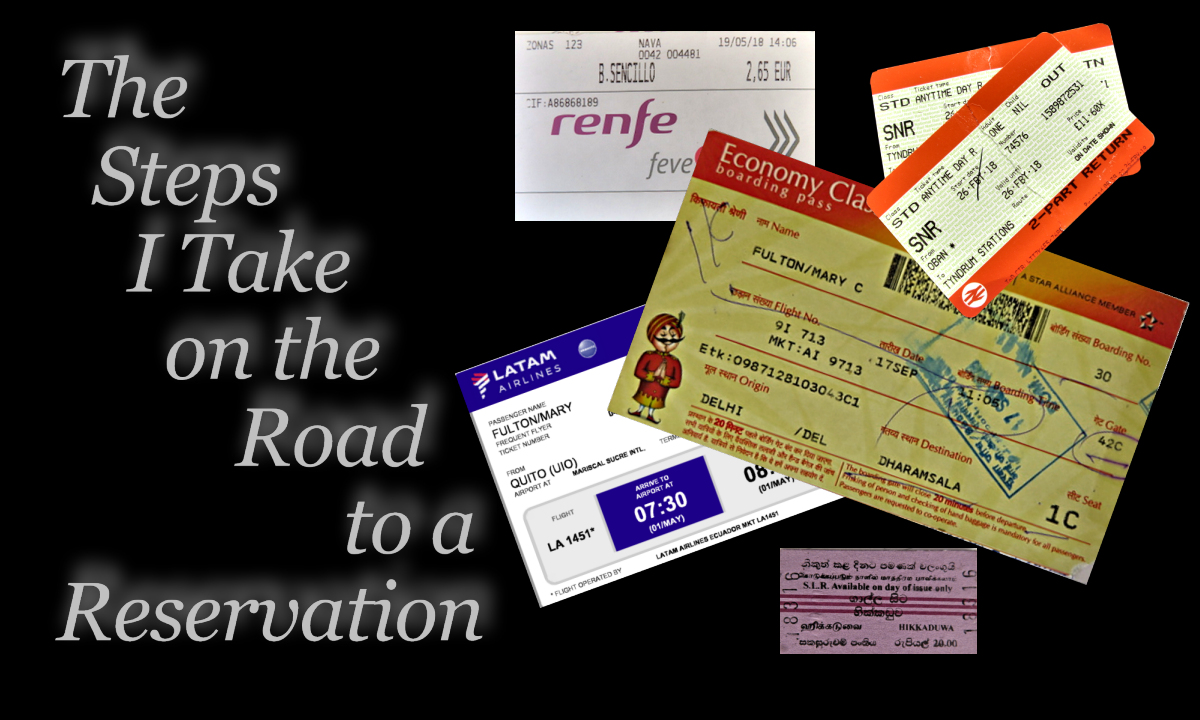Learn how I plan a train journey from London to Tbilisi
Look Over My Shoulder
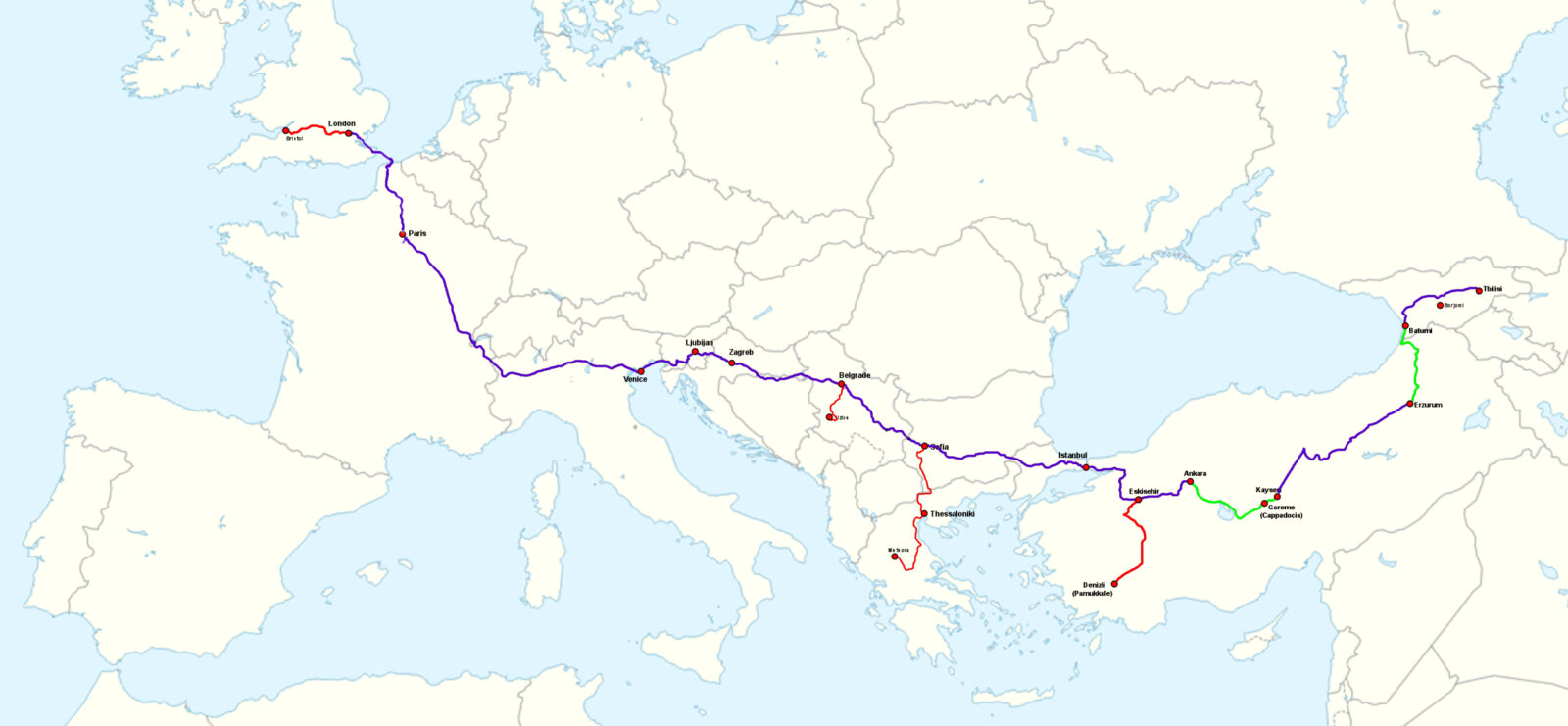
Stage 6: In-Depth Research Begins
This is Part 6 of a series of articles walking you through my travel planning process—from barely an idea to reservations and actual travel. I recommend reading the articles in order:
Stage 1: Introduction & the Dreaming/Brainstorming Stage
Stage 2: Solidifying My Goals
Stage 3: Building a Skeleton Itinerary
Stage 4: Testing My Budget
Stage 5: Gathering Logistics
Now for the fun part! I love researching potential places to go, things to do, people to meet, food to eat. I even like to research and solidify transportation options and lodging.
If you are like me, this will be a mish-mash of planning. I can really jump around the internet—checking out lodging possibilities one day, and then a few train schedules, which may get interrupted when I locate some blogs about the food of the country. This post will show you how I keep it all straight. It is the final stage of my travel planning and the result is a personal guidebook to be used on the journey.
My Planning Document
During this phase I will flesh out that skeleton itinerary document I began in Part 3. It now becomes my main planning document. It is here where I save links to interesting blog posts, museum and attraction websites, special guesthouses or hostels, and activities I would enjoy. I can also make notes to myself about options and possibilities.
Here is a sample page from that document. Each destination has a new section. This is easily created in any text processing program. I use MS Word. Google Docs is an option that is free.
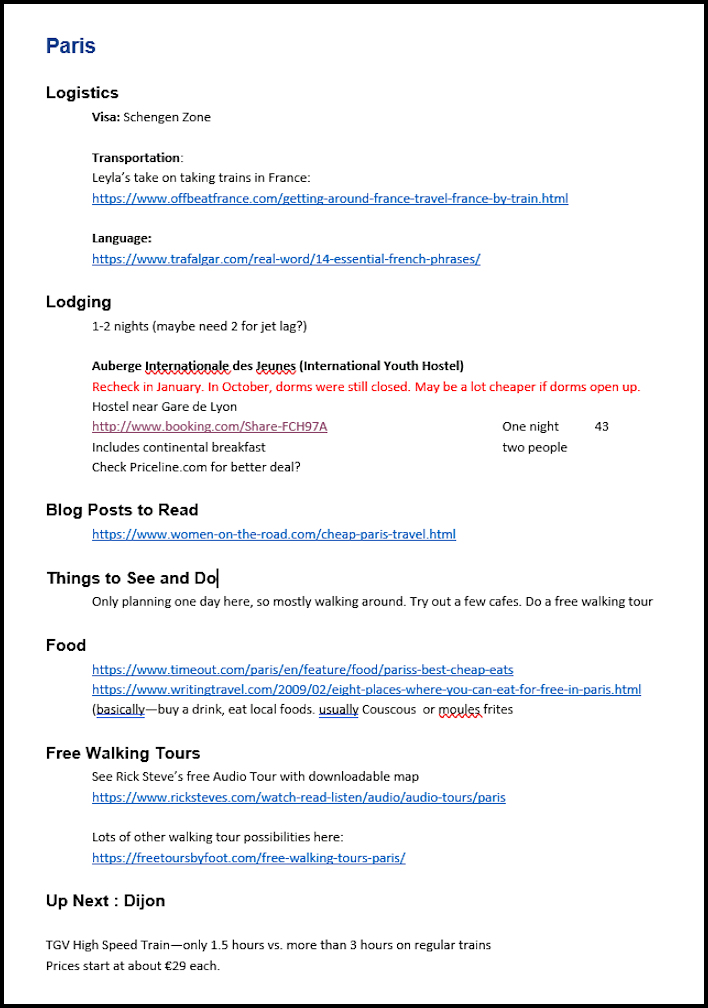
Alternatively, there are many kinds of note-taking apps available that help you automatically categorize and sub-categorize topics. I have successfully used One-Note in the past.
Once I begin the trip, this will become my customized guidebook as I move from destination to destination.
Here are the headings I have under each destination with descriptions of the kinds of things I keep track of under each heading.
Logistics
- Visa requirements, currency, language, etc. (from my Part 5 spreadsheet)
- How to get around (like how the local busses work)
- Help with understanding the language—like a few key phrases, or how the alphabet works.
Lodging
Now is the time to pick out a few places to stay that sound promising for me, and I copy the links from the booking sites.
Blog Posts of Interest
For each country or city, I search using the phrases “Winter travel in _______” and “Off the Beaten Track in ________” and “Free Walking Tours _______”
As I come across related in-depth articles about my destination, I begin creating a reading list.
Places to go/Things to see and do
- Possible Excursions
- Free Walking Tours
- Winter Experiences
Foods to try
Because I love to shop in traditional markets, I begin a list of the best ones to visit
Knitting/Fiber possibilities and Meeting Locals
- This heading reflects my interest in the fiber arts and the fact that I try to meet other people who knit and spin yarn on my travels. It is a great way to break the ice when meeting locals and other travelers.
- I talk a lot about this in my article and free on-line video workshop about thematic travel here.
- You should substitute your own special interests here. For example, I have a friend who loves to salsa dance. Almost anywhere she goes in the world, she finds a place where people are dancing salsa.
Up Next: How to get to the next location
- Train schedules, fares, links to on-line ticketing.
- Special instructions regard things like border crossings and transfers.
- Where and how to purchase tickets. Are advance-purchase tickets advantageous?
- How to arrange a sleeping car, when appropriate.
- Whether or not I need to pack my own food for the journey. Some trains do not offer food service on board.

Other Things I Keep Track Of
As I do research, I find there are also lots of other details to keep track of. At the beginning of my planning document, I dedicate a section to the miscellaneous things I don’t want to forget.
- Reminders of things I still need to research. I usually highlight these in some way.

- Budget updates. As I fine-tune my budget, I update some of the cost estimations in a spreadsheet. This will help me keep my budget on track.
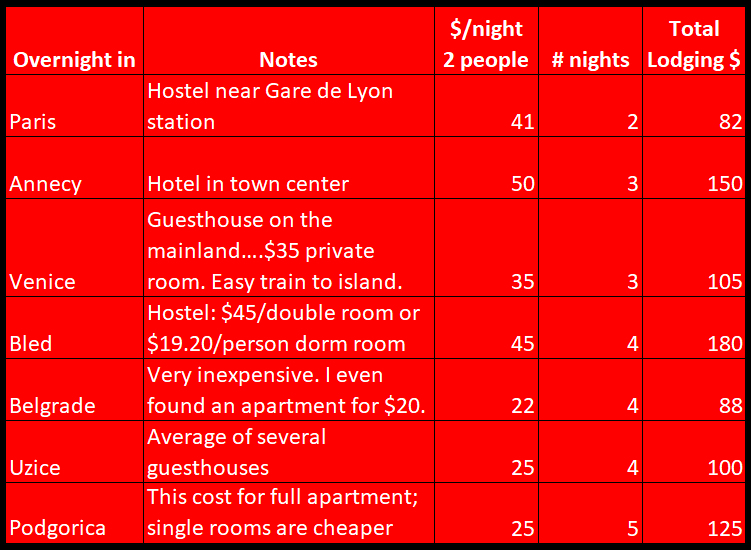
- Pre-trip Preparations
There seem to be a million things to take care of in the months before a long-term trip. Women on the Road provides an exhaustive list in her excellent article, “Your Long-Term Travel Checklist.” (Even though the title says the list is for women, it would be useful for anyone planning a long-term trip.)
Here are just a few of the things on the list. I highly recommend reading the entire article.
At one year before the trip: “Start picturing the trip in your mind: why you’re going, what you expect from the trip”
At six months before: “Start tightening your belt and cutting back on unnecessary expenses.
At four months: “Apply for discount cards – student card, senior card – all these will get you discounts as you travel.”
At two months: “If you’re backpacking, load everything into your pack and start walking around with it each day to get used to the weight.” And “Research your long-term travel insurance.”
At one month: “Sign up for a VPN service if you plan to get online overseas”
At two weeks: “By now you should know if your pack is too heavy or your suitcase or bag too full…cut back”
At one week: “Photocopy or scan your important papers.”
On the day: “Make sure you give yourself enough time to get to the airport serenely.”
Sometimes I Change My Mind
You can see that my document is fairly rough. This is only for my own use, so I don’t try to make it “pretty.” I slowly add information as I discover it. This is a weeks-to-months long process. As I become more informed, I may eliminate some destinations and add others.
For example, when I studied Turin, Italy more closely, I discovered that it did not sound as interesting as it did at first, so I decided to travel directly from Annecy to Venice and spend an extra day in Venice.
My daughter told me she would really like to visit Montenegro, so I added a detour to my journey.
Mapping the Journey
I love maps and I like to use my graphic design program to create them, so, just for fun, I mapped my rail journey. It turned out to be another useful document. It was nice to visualize the routes and have a better understanding of the distances. I shared the image with a traveling friend and as a result, she and I may get to meet up in places along the way!

You can also use a travel planning app, like TravellersPoint.com, to create a map. Google has a way for you to plot personalized maps on MyMaps.
And there is nothing wrong with pinning a map to the wall. Cover it with clear acrylic to make your own wipe on/off board so you can trace routes and destinations. Use sticky notes to capture even more details.
Tentative Calendar
Another useful document is a tentative calendar. Of course, the way I travel, it is bound to change as I do more research . Some places I will leave sooner than expected; in others, I will stay longer. I will learn about places and people to visit along the way and make detours. But, like the map, a calendar is a good way to keep track of how much time the trip will actually take. When I first created a tentative calendar, I discovered that this trip might take as long as two months!
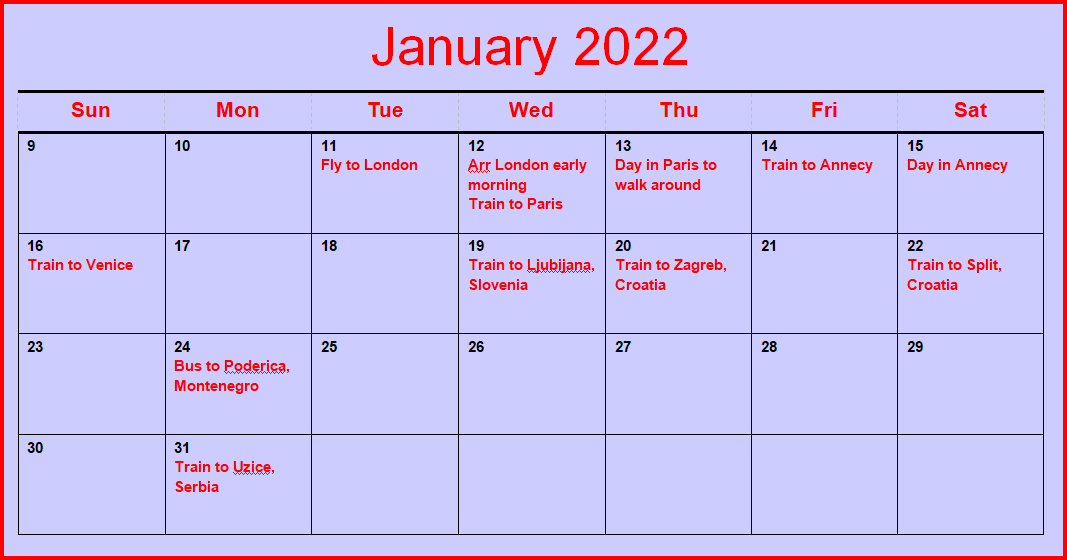
Adding and deleting days to a flexible calendar while researching destinations MAY keep me on track to complete the journey in less than my planned two months. (Yes, I know, I originally thought I would only take about a month!)
It will also be a useful tool during the trip. I often change plans while traveling. This calendar will show the fallout if I decide to stay a few extra days in Split, for example. That may mean that I have to reduce my time in Serbia down the road.
This Will Keep Me Busy for a While
As I am writing this post, I am still in the detailed planning stage of my next trip. I have already added and deleted destinations. And of course, I keep finding hidden gems that I must explore. So, this journey is evolving and will continue to do so even after I embark.
I will continue to keep you updated as things develop. It is October 2021 and COVID may still have some curve balls to throw at us. My daughter will join me on this trip, and we plan to begin the journey in February 2022. I hope we are prepared to forego the trip if necessary.
Making Reservations
Committing myself to specific travel dates for this trip is still in the future. But, if you would like to learn about my methods for reserving accommodations and buying tickets NOW, read my travel guide, “The Steps I Take on the Road to a Reservation” here.
I hope you have found this series on travel planning useful. Please leave comments below on what has worked for you and share some of your tips for making the travel planning process fun and rewarding.
Want to be notified when I publish a new post about how I travel?
Subscribe to my Newsletter here:
And don’t worry…I hate spam too. You can unsubscribe at any time.
Other Blog Posts You May Find Interesting
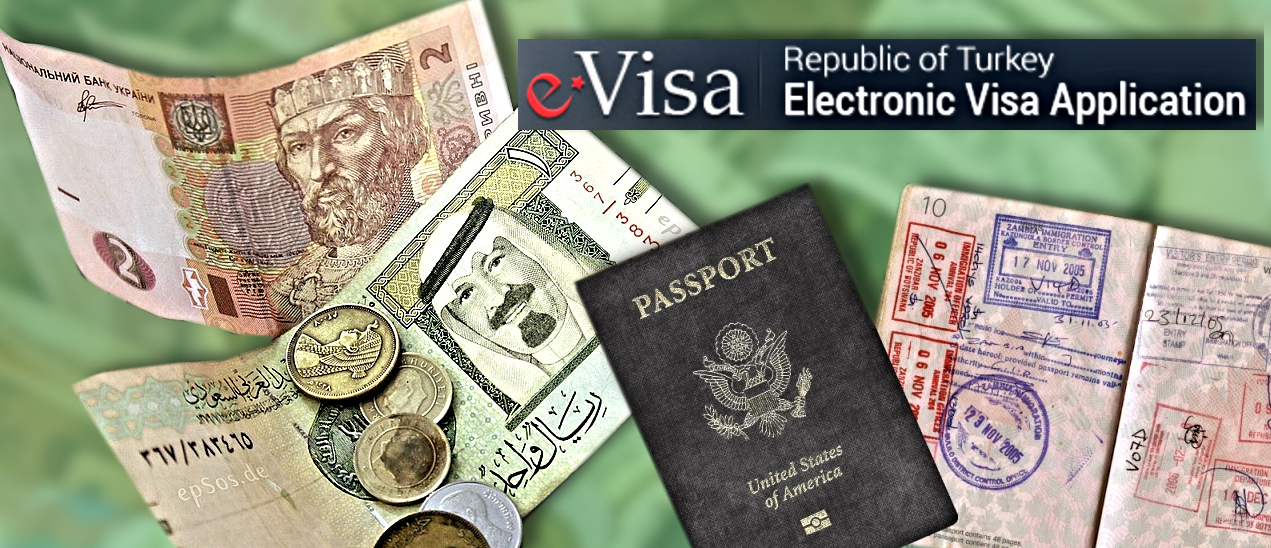
Look Over My Shoulder Stage 5
Since I am visiting so many different countries, it would be useful to know (and keep track of) basic information about each one.
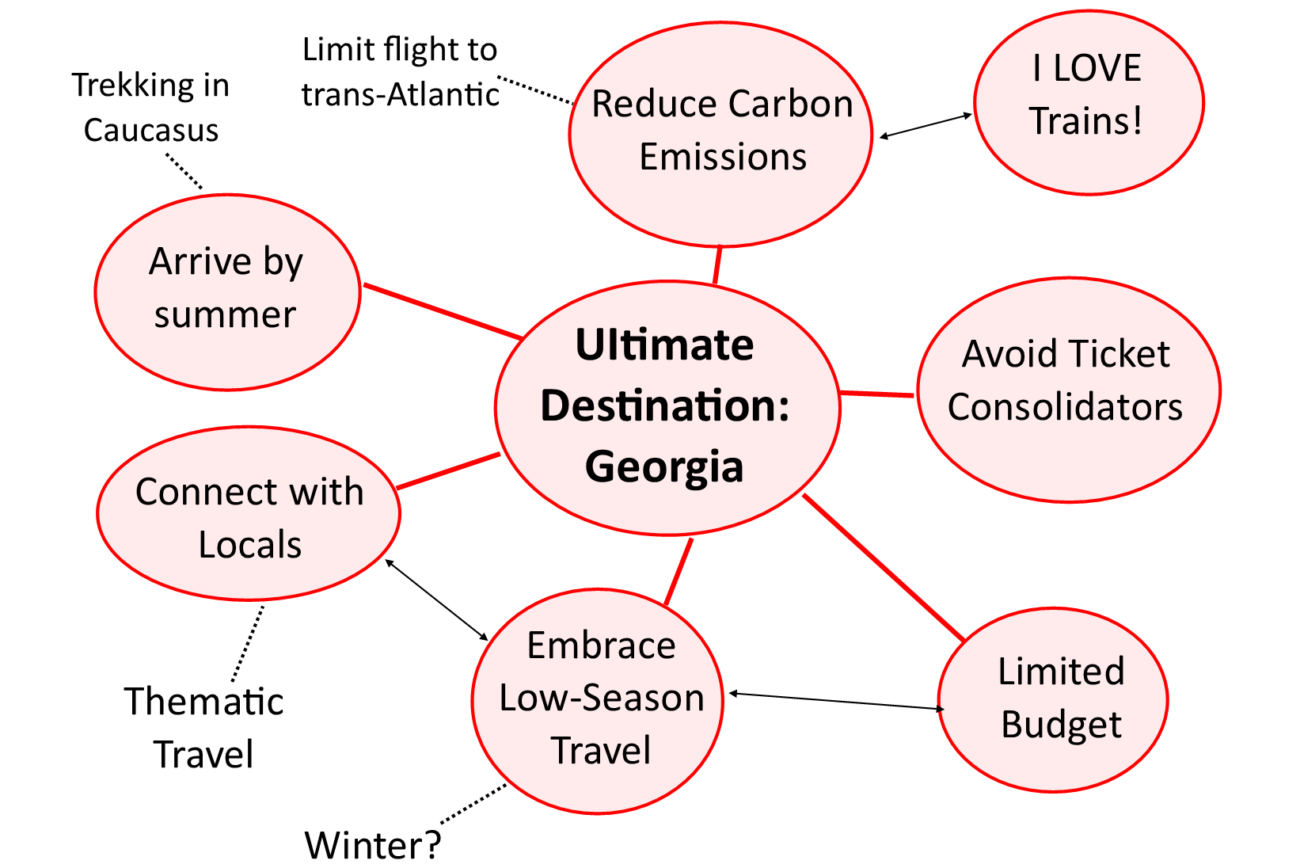
Look Over My Shoulder Stage 2
Today’s post is quite rambling, following my disparate thoughts from one idea to another. But travel planning—especially a lengthy journey—is rarely straightforward. And in my case, it is usually a pretty messy and disorganized process.
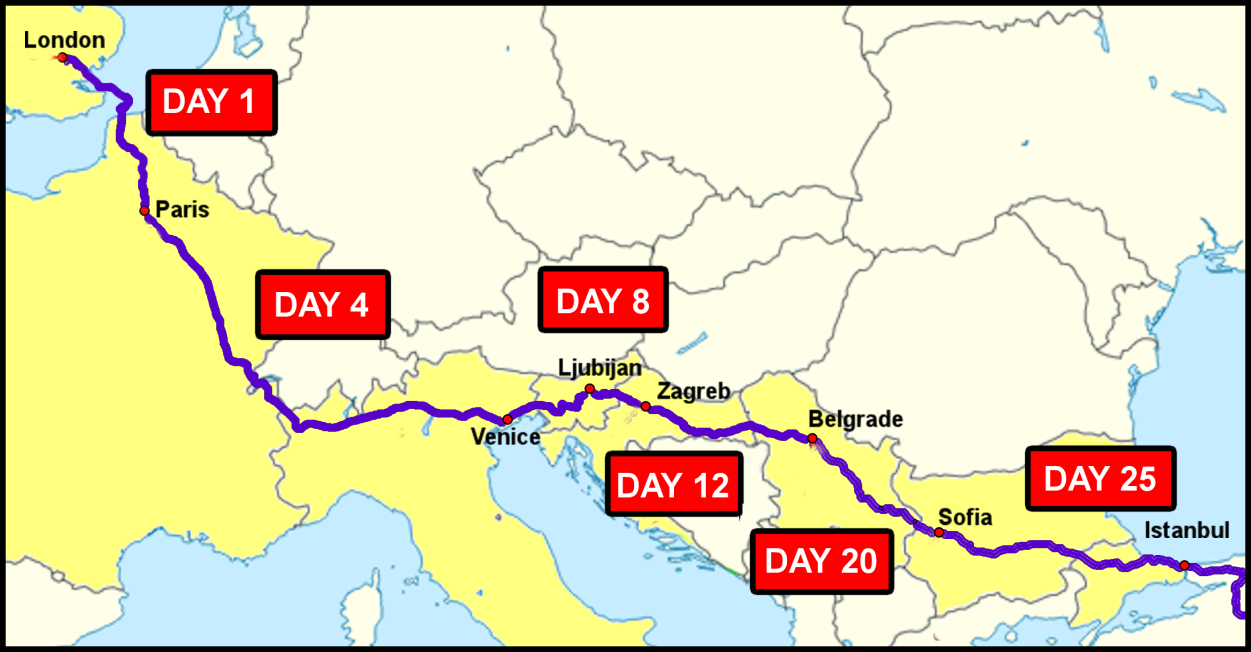
Look Over My Shoulder Stage 3
In Stages 1 and 2, I brainstormed my next journey and began solidifying my goals—where I want to travel and why. Now I can begin building a draft itinerary.

